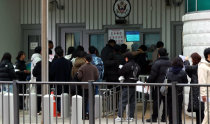Drowning in Debt
Korea Land and Housing Corp., the product of a merger between Korea Land Corp. and Korea Housing Corp., is reeling under the weight of a massive debt of 108 trillion won (100 billion U.S. dollars). The merged companys debt is equivalent to 30 percent of Koreas national debt of 366 trillion won (320 billion dollars). The daily interest alone on the debt is an astounding 7.4 billion won (seven million dollars), so the figure continues to grow over time. Under this circumstance, the company has not paid compensation for appropriated land on time or has delayed paying construction workers wages, resulting in collective civil complaints against it. It has also failed to issue bonds because it could not honor maturing debts on time.
The company saw its debt snowball under the previous Roh Moo-hyun administration. The figure rose from 20 trillion won (18 billion dollars) in 2003 to 28 trillion won (25 billion dollars) in 2004, 67 trillion won (59 billion dollars) in 2007, and 109 trillion won (100 billion dollars) last year, a five-fold increase over six years. The main culprit for the rise was the overexpansion of projects to build rental houses and new towns and to develop residential property in a short period of time. The Sejong City project and the relocation of U.S. military bases were among such projects initiated by the Roh government. Debt stemming from state projects alone amount to up to 37 trillion won (33 billion dollars). Such populist-oriented state projects changed the company into a state-run behemoth saddled with a massive debt.
The expectation was that the merger of the land and housing corporations would improve the new companys managerial efficiency through the disposal of overlapping assets. The incumbent administration said the merged companys combined assets of 153 trillion won (140 billion dollars) will help debt repayment and improvement of managerial conditions. The company, however, is hardly in a position to sell its real estate holdings due to the slump in construction. If it fails to significantly reduce its debt, it could be forced into bankruptcy. In a desperate move, the company will sell assets worth 30 trillion won (27 billion dollars), including housing properties, at low prices this year. By tallying unsold land and homes, the company will put them on sale along with its headquarters building and 10 branch offices in the provinces. If the company attempts to sell its property in a rush, it could incur a loss resulting from sale at basement prices.
In light of the mistakes committed by its predecessor, the incumbent administration also must learn lessons. The government has seen the fixed share of welfare spending from its budget grow. Korea Water Resources Corp. is set to incur a mounting debt due to the four-river restoration project. The five state-run companies with the highest debt Korea Electric Power Corp., Korea Expressway Corp., Korea Gas Corp., Korea Rail Network Authority and Korea Railroad each have more than 20 trillion won (18 billion dollars) in debt. They must drastically slash spending and repay debt to prevent a disaster.
Generous state projects aimed at winning votes and raising approval ratings will eventually levy a long-term burden on succeeding administrations. This applies to not only the debts of state-run companies but also government budgets. The Korea Institute of Public Finance said, The pace of Koreas budgetary deterioration is faster than that of the European Union, adding, The national debt will reach 116 percent of GDP in 2050.






![노동신문 개방? 노동신문 서버는 개방을 견뎌낼까?[주성하의 ‘北토크’]](https://dimg.donga.com/c/138/175/90/1/wps/NEWS/IMAGE/2025/12/26/133032325.1.jpg)
